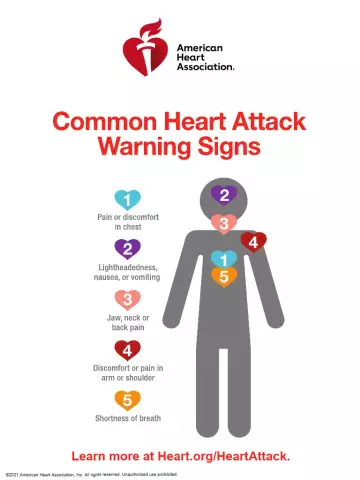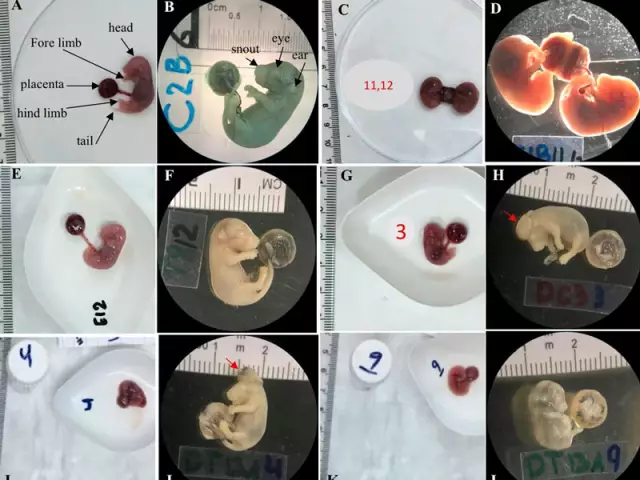- Author Rachel Wainwright [email protected].
- Public 2023-12-15 07:39.
- Last modified 2025-11-02 20:14.
Congenital heart disease
Brief description of the disease

Congenital heart disease is an anatomical defect of the heart, its vessels, or valves, which occurs even in utero.
Congenital heart disease in babies may be invisible, but it may appear immediately after birth. On average, this disease occurs in 30% of cases and ranks 1st among the diseases that cause death of newborns and children under one year old. After a year, the mortality rate falls, and at the age of 1-15 years. about 5% of children die.
There are seven main types of congenital heart disease in newborns: pathology of the interventricular septum, pathology of the interatrial septum, aortic coarctation, aortic stenosis, patent ductus arteriosus, transposition of great great vessels, pulmonary artery stenosis.
Reasons for the appearance
The main reasons for the appearance of a congenital defect are external influences on the fetus in the 1st trimester of pregnancy. A viral disease of the mother (for example, rubella), radiation exposure, medication, drug addiction, and alcoholism of the mother can cause a defect in the development of the heart.
The health of the child's father also plays an important role, but genetic factors in the development of congenital heart disease in children play the least role.
The following risk factors are also distinguished: toxicosis and the threat of miscarriage in the 1st trimester, the presence in the past of pregnancies ending in the birth of a still child, the presence in the family history of children with congenital defects (in the next of kin), endocrine pathologies of both spouses, the age of the mother.
Congenital heart disease symptoms
In newborns with congenital heart disease, a bluish or blue color of the lips, ears, and skin is noted. Also, cyanosis in a child can appear when he screams or sucks. Bluish skin color is characteristic of the so-called "blue heart defects", but there are also "white congenital defects", in which the child has pale skin, cold hands and feet.
Noises are heard in the child's heart. This symptom is not the main one, but if it is present, you should take care of additional examination.
There are cases when the defect is accompanied by heart failure. In this case, the prognosis is in most cases unfavorable.
Anatomical pathologies of the heart can be seen on the ECG, echocardiogram, and X-rays.
If the congenital heart defect is not noticeable immediately after birth, the baby may look healthy for the first ten years of life. But after that, a deviation in physical development becomes noticeable, cyanosis or pallor of the skin appears, and shortness of breath appears during physical exertion.
Diagnosis of the disease
The doctor makes the primary diagnosis by examining the child and listening to the heart. If there is reason to suspect a congenital heart defect, the child is sent for further examination. Various diagnostic methods are used, there is also the opportunity to examine the fetus in the womb.
Fetal echocardiography is used to examine a pregnant woman. This is an ultrasound diagnosis that is safe for the mother and the fetus, allowing to identify pathology and plan the treatment of congenital heart disease.
Echocardiography is another type of ultrasound examination, but for a child who has already been born, it helps to see the structure of the heart, defects, narrowed vessels, and to assess the work of the heart.
Electrocardiography is used to assess cardiac conduction, the work of the heart muscle.
Chest x-rays are used to determine heart failure. So you can see excess fluid in the lungs, expansion of the heart.
Another X-ray method for detecting congenital heart disease is vascular catheterization. Contrast is injected into the bloodstream through the femoral artery and a series of X-rays are taken. So you can assess the structure of the heart, determine the level of pressure in its chambers.
To assess the oxygen saturation of the blood, pulse oximetry is used - with the help of a sensor worn on the child's finger, the oxygen level is recorded.
Congenital heart disease treatment
The method of treating the defect is chosen depending on its type. Thus, minimally invasive procedures with catheterization, open surgery, transplantation, and drug therapy are used.
The catheter technique allows for the treatment of congenital heart defects without radical surgery. A catheter is inserted through a vein in the thigh, under X-ray control it is brought to the heart, and special thin instruments are brought to the site of the defect.

The operation is prescribed if it is not possible to use catheterization. This method differs in a longer and more difficult recovery period.
Sometimes surgical treatment of congenital heart defects, mainly in severe cases, is carried out in several stages.
For defects that cannot be treated, a heart transplant is indicated for the child.
Drug therapy is often used to treat adults and older children. With the help of medications, you can improve heart function, ensure a normal blood supply.
Prevention of the disease
Conventionally, the prevention of congenital heart defects is divided into the prevention of their development, the prevention of their unfavorable development and the prevention of complications.
Prevention of the occurrence of a defect consists more in medical and genetic counseling at the stage of preparation for pregnancy, than for any specific actions. For example, one should warn about the undesirability of pregnancy in a woman in whose family (or in the family of a partner) there are three or more people with birth defects. It is not recommended to give birth to children for a married couple where both partners suffer from this disease. A woman who has suffered rubella should be carefully examined.
To prevent the unfavorable development of the disease, it is necessary to carry out the necessary diagnostic procedures in time, select and carry out the optimal treatment to correct the condition. A child with a congenital defect who has undergone treatment requires careful special care. Often, the mortality of children with congenital defects under one year of age is associated with insufficient child care.
For the prevention of complications of the disease, one should deal with the prevention of these complications directly.
Due to congenital heart disease, there may occur: bacterial endocarditis, polycythemia ("blood thickening"), causing thrombosis, headaches, inflammation of peripheral vessels, cerebral thromboembolism, respiratory diseases, complications from the lungs and their vessels.
YouTube video related to the article:
The information is generalized and provided for informational purposes only. At the first sign of illness, see your doctor. Self-medication is hazardous to health!






